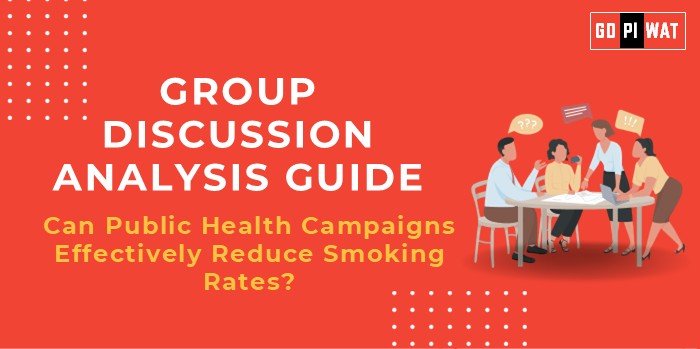📋 Group Discussion (GD) Analysis Guide
🌐 Can Public Health Campaigns Effectively Reduce Smoking Rates?
💡 Introduction to the Topic
Opening Context: Smoking remains a significant global public health challenge, causing over 8 million deaths annually. Public health campaigns have emerged as a primary tool to combat tobacco consumption.
Topic Background: Governments and NGOs have implemented awareness programs, taxation policies, and graphic warning labels to discourage smoking. The World Health Organization’s Framework Convention on Tobacco Control (WHO FCTC) provides a global blueprint for tobacco control.
📊 Quick Facts and Key Statistics
- Global Smoking Prevalence: 22.3% of the global population smokes, with significant regional disparities (WHO, 2023).
- Tobacco-Related Deaths: Over 8 million annually; 1.2 million are due to secondhand smoke exposure (CDC, 2023).
- India’s Efforts: Cigarettes and Other Tobacco Products Act (COTPA) 2003 mandates warnings on packaging.
- Economic Impact: Smoking-related illnesses cost the global economy over $1.4 trillion annually (Tobacco Atlas, 2022).
👥 Stakeholders and Their Roles
- Governments: Implement and enforce anti-smoking laws, taxation, and public awareness campaigns.
- Healthcare Providers: Offer smoking cessation programs and support systems.
- NGOs and Advocacy Groups: Advocate for stricter regulations and support grassroots campaigns.
- Citizens: Adopt healthier lifestyles and support community initiatives.
- Tobacco Companies: Contribute to the challenge with aggressive marketing but are potential participants in harm-reduction strategies.
🏆 Achievements and Challenges
🎉 Achievements:
- Smoking rates have dropped globally from 33% (2000) to 22% (2023) due to campaigns and policies.
- Australia’s plain packaging law reduced smoking prevalence by 12% in the first three years.
- India’s ban on smoking in public places (2008) decreased urban smoking rates by 18%.
⚠️ Challenges:
- High smoking rates persist in low-income countries due to weak policy enforcement.
- Alternative nicotine products, like e-cigarettes, complicate regulatory efforts.
- Cultural norms and misinformation hinder progress in certain regions.
🌍 Global Comparisons:
- Success: New Zealand’s “Smokefree 2025” initiative demonstrates a robust, multi-pronged strategy.
- Challenges: Indonesia’s weak regulatory framework sustains one of the world’s highest smoking rates.
📚 Structured Arguments for Discussion
- Supporting Stance: “Public health campaigns like India’s anti-tobacco ads during movies significantly raise awareness and deter smoking.”
- Opposing Stance: “The influence of the tobacco industry and addiction complexity limits campaign effectiveness.”
- Balanced Perspective: “Public campaigns are necessary but must be complemented by robust legislation and cessation support systems.”
✨ Effective Discussion Approaches
- Opening Approaches:
- Start with compelling statistics, e.g., “Every year, smoking claims more lives than HIV/AIDS, malaria, and tuberculosis combined.”
- Highlight a case study, e.g., “Australia’s plain packaging law serves as a model for tobacco control.”
- Counter-Argument Handling:
- Cite evidence of mixed success, such as countries where smoking rates remain stable despite campaigns.
- Suggest integration of taxation and smoking cessation programs.
🔍 Strategic Analysis of Strengths and Weaknesses
- Strengths: Proven impact of warning labels, widespread awareness, global collaboration via WHO FCTC.
- Weaknesses: Enforcement gaps, socio-economic disparities, tobacco industry resistance.
- Opportunities: Digital campaigns, youth-focused interventions, and emerging harm-reduction strategies.
- Threats: Rise of vaping, economic dependency on tobacco farming in developing countries.
🎓 Connecting with B-School Applications
- Real-World Applications: Public health management, behavioral economics, and corporate social responsibility projects.
- Sample Interview Questions:
- “How can governments balance public health objectives with economic concerns in tobacco control?”
- “What role does behavioral science play in designing effective anti-smoking campaigns?”
- Insights for B-School Students: Understand the interplay of policy, marketing, and societal behavior in addressing complex issues like smoking.


